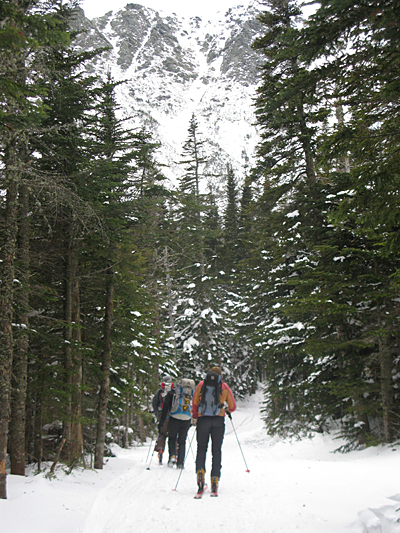I'm back from an excellent weekend at my avalanche awareness course. FYI, if you tell relatives and friends you're going to avalanche class for the weekend, a few will imagine some very extreme activities. Actually, the first day was spent mostly in a classroom looking at PowerPoint slides, listening, discussing, asking questions, and listening some more. The second day took us into the snow on Mount Washington.

Skiing and hiking up to Tuckerman Ravine on Mount Washington.
Fortunately, I took my class with an excellent instructor and mountain guide, so both the classroom and field portions were very engaging and informative.
Here are some things I learned that I might never have learned from reading a book or practicing by myself.
- Relative avalanche newbies, like me, come in just wanting to know what factors are "good" and which are "bad." Well, guess what. Anything that can be "good" can be "bad" and vice versa. It's all about context. Wind can be bad, except when it's good. Trees can be good, except when they're bad.
- Not all good decisions have good outcomes; not all bad decisions have bad outcomes.
- Eight students all will eagerly volunteer to dig a snow pit if it's cold enough out.
- Just because nothing bad happens, doesn't mean you didn't make a mistake. And you will make a mistake. Most of the time you get away with it. Except when you don't.
- Speaking of mistakes, you can understand how to search with a beacon. Then you'll check every piece of gear in a debris field except one glove, get distracted by your beacon to find one buried "victim," then find the second victim with your beacon, which would be great, except that the second victim's glove is clearly visible on top of the snow and you could have just run over and picked it up to locate them in the first place. As embarrassing as this was, luckily I did it in a fake scenario, where the lesson will do me some good. I can't get sucked in by the beacon, focusing on perfect beacon technique, rather than looking at obvious clues to save someone's life.
- Inclinometer: there's an app for that. Check the iTunes store.
- Just how complicated and how simple avalanches are. Because I'm a relative newbie, I'll focus on the latter part of that. As our instructor said, "be careful of overthinking it. Ultimately it's all snow sliding down a hill."
- On the flip side, how much, much more I have to learn. I should have taken this course years ago, but didn't (despite winter wanderings in some White Mountain avalanches terrain). I reasoned that I don't go out in anything but low avalanche conditions and I was more of a hiker/climber (versus skier), as if avalanches care what activity you're doing.
- A great guide/instructor makes all the difference (thank you, Marc Chauvin). Ask people you know for recommendations.
As hoped, I learned a lot about what I don't know, but also gained some good decision-making skills and a strong basic understanding of avalanche terrain, factors, triggers, and rescue protocol (check the glove you idiot!). No matter how good the instructor is, I know better than to think I now know what's going on where avalanches are concerned thanks to a two-day class. So, I'll keep practicing scenarios, educating myself, and consider a more advanced class when I'm ready for it down the road.

 by Alicia MacLeay
by Alicia MacLeay









